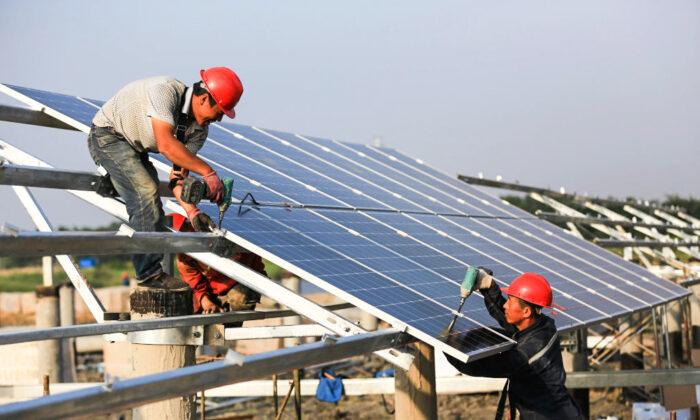An analysis by a nonprofit research group claims that the United Nations organization on climate change has been drastically underestimating the carbon intensity of Chinese-made photovoltaic cells.
Specifically, the IPCC claims that the carbon footprint of solar panels—most of which are made in China—is about 48 grams of carbon dioxide (CO2) per kilowatt-hour (kWh). But Environmental Progress said in a bombshell report that research carried out by Mr. Mariutti suggests the true carbon emissions are closer to 170 grams to 250 grams of CO2 per kWh—between three to five times higher than reported by the U.N.
‘Dirty Secret’
In April, Mr. Mariutti, an analyst specializing in economics as well as climate and energy policy, published a report titled “The Dirty Secret of the Solar Industry.” In the report, he argued that the IPCC was vastly underestimating the amount of carbon generated by Chinese-made photovoltaic cells because it was basing its calculations on a Europe-based, low-carbon supply chain rather than the coal-reliant production processes in China.“We are investing hundreds of billions of dollars a year in technologies that are low-carbon only because someone wrote it down somewhere,” Mr. Mariutti said in the executive summary of his report. “There aren’t any national or international authorities who have bothered to understand on what basis and how this ‘paper knowledge’ was assembled.”
The problem is that most of the carbon intensity data that the IPCC—and governments—rely on for solar panels are based on modeling that’s likely to have vastly underestimated the carbon emissions of solar power because of a lack of transparency, or simply inaccurate or “made-up” data from Chinese manufacturers, according to the Environmental Progress report.
Over the years, China has become a dominant force in the production of solar panels. For example, about 97 percent of the global supply of solar wafers—a key component of photovoltaic cells—are made in China.

However, China’s growing share of the solar panel market hasn’t come about because of innovation.
“The majority of experts consulted by Environmental Progress agree that China’s competitive advantage did not lie in an innovative new technological process, but rather in the very same factors the country has always used to outcompete the West: cheap coal-fired energy, mass government subsidies for strategic industries, and human labor operating in poor working conditions,” according to the group’s report.
He said he felt it was his duty to make his research public in order to inform public policy decisions.
“In the last 10 years, the IPCC has systematically underestimated the carbon intensity of photovoltaic energy by pretending that photovoltaic modules are produced in Europe rather than in China,” he said at the time.
“By recalculating the carbon footprint of a photovoltaic system on the basis of a predominately coal-based energy mix, it is possible to estimate that the global average carbon intensity of photovoltaic energy is at least 200 [grams of CO2 per kWh].”
Solar Panel Waste Tsunami

“We’ve been in a sort of hypnotic trance,” Mr. Shellenberger said at the time, referring to what he characterized as the misguided belief that solar power is an environmentally friendly alternative to traditional forms of power generation such as nuclear.
“It’s a spiritual pursuit,” he said. “There’s the idea that ... we’ll protect the natural environment by being dependent on natural energy flows like sunlight. It’s not a scientific view. It actually is worse for the environment.”
Asked about the study, Mr. Shellenberger confirmed the high recycling costs but said that they’re just one part of the end-of-life burden of solar energy. The panels contain heavy metals such as lead, which can be released as a toxic cloud if the panels shatter during disposal.
“It’s hazardous waste,” he said at the time.
With the proliferation of renewable energy sources, especially solar power, in the United States, the issue of tackling waste has become a growing concern.
The United States currently has an estimated 149.5 gigawatts of solar capacity installed nationwide.







